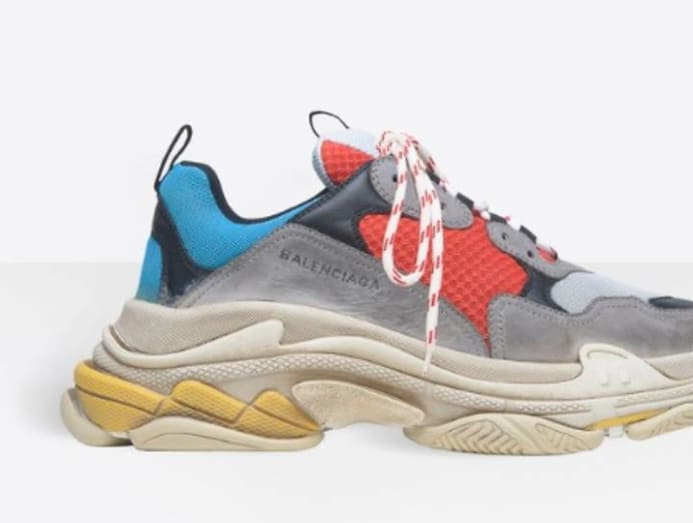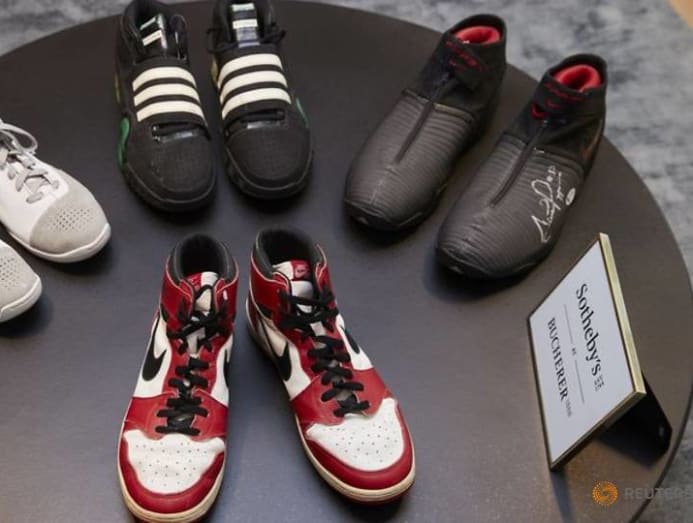Commentary: How sneakers went from sports shoes to become cultural symbols and cult items
NOTTINGHAM, England: Sneakers, once the symbol of athleticism, accept transcended their primary function to get commercial and stylish objects of want.
From sportswear and street manner to catwalk manner, sneakers have made their mark as cultural commodities.
The global sneaker market valued at approximately United states$79 billion in 2022 and is predicted to reach U.s.a.$120 billion past 2026. With such huge growth, it is unsurprising that they are considered large business.
Such are the strides in the sneaker industry that a new exhibition at London's Design Museum explores how the shoe became an undisputed cultural symbol of our times.
READ: IN FOCUS: Foot Locker crowds offer glimpse into cut-pharynx world of reselling sneakers
READ: Commentary: Making S$30,000 a month from sneakers? This is why nobody likes resellers
COMFORT IS Male monarch
The last decade has seen a huge shift in how sneakers are worn. Donning a pair is no longer frowned upon in the workplace or on more than formal occasions. Even British etiquette experts Debrett's take given their seal of approving, deeming them socially acceptable for smart casual occasions.
The continued authorization of the athleisure trend has had a significant touch on the growing sales of sneakers – forth with the pursuit of comfort. This just grew more during the pandemic as lockdowns fabricated people further prioritise comfort, which resulted in a ascension in sales of loungewear, athleisure and flat shoes, similar sneakers.
As such, sneakers take moved from the niche to become coveted every bit fashionable objects. Footwear is now the biggest selling category in the online luxury market and sneakers have made a pregnant contribution to this growth.
High style brands from Gucci to Balenciaga are setting the pace in the luxury sneaker market. In 2017, Balenciaga's Triple South became the biggest seller in the luxury sneaker market and its popularity seems unstoppable.

To understand how the sneaker has emerged to get a footwear phenomenon, it is important to trace its legacy from office to cultural icon.
FROM Lawn tennis SHOE TO Rails
The earliest sports shoes were created by The Liverpool Safety Company, founded by John Boyd Dunlop, in the 1830s. Dunlop was an innovator who discovered how to bail sail uppers to safety soles. These were known as sandshoes and worn by Victorians on their beach excursions.
Historian Thomas Turner defines the latter decades of the 19th century every bit a time when industrial progress and social change were twinned with a growing enthusiasm for sporting pursuits, in particular backyard lawn tennis.
This resulted in the need for a more than specialised type of footwear, which Dunlop's prophylactic sole could fulfil. Dunlop launched their now iconic, Green Flash model in 1929, which was worn by tennis legend Fred Perry at Wimbledon.
READ: Commentary: The ascent of the super shoe and how endurance runners are smashing records
Other meaning sports shoes of the 20th century included the Converse All Star, designed for basketball. However, it is Adidas and Nike that have both shaped the sneaker'southward development from sport to style.
Founded by Adi Dassler in Germany in 1924 equally "Gebruder Dassler Schuhfabrik", the company afterwards rebranded every bit Adidas in 1949. The brand created the first track shoe with a complete leather sole and paw-forged spikes, which was worn by Jessie Owens at the 1936 Berlin Olympics.
Nike was created by Bill Bowerman and Phil Knight in 1964 equally Blue Ribbon Sports and became Nike Inc in 1971. This coincided with the running craze that striking America.
Nike's first commercial design was the Cortez, cushioned for running. The Cortez was worn by Tom Hanks in Forrest Gump, securing Nike'south cultural condition.
Merely for kicks: A roundup of the coolest sneakers you'll desire to own
THE COMMERCIALISATION OF COOL
Enquiry past the sociologist Yuniya Kawamura on sneakers defines iii waves of the phenomenon. The first moving ridge in the 1970s was divers by an hole-and-corner sneaker culture and the emergence of hip-hop.
Adidas' Samba design, every bit a key example, became a key office of Terrace Fashion inside football fan subculture. In 1986, Run-DMC released the song My Adidas, leading to a sponsorship deal with the make. This forged the sneaker's deep-rooted place in pop civilisation.

The second wave of the miracle began in 1984 with the launch of Nike Air Jordans. This gave rise to the commodification of sneakers and their desirability as status items, fuelled through celebrity endorsements.
For Kawamura the tertiary wave is marked by the digital age and the resulting growth in sneaker marketing and resell culture. The global sneaker resale market place was valued at United states$vi billion in 2022 and is forecast to be worth Usa$30 billion by 2030.
The growing presence of "sneakerheads" who collect and trade sneakers have ensured that they maintain cult status. Nike and Adidas routinely release limited editions shoes associated with a celebrity, hip-hop star or athlete.
READ: Commentary: The COVID-xix crisis has put luxury brands in a set up
READ: Commentary: The rise and rise of the sneaker
It is not unusual for people to go to extreme lengths to get their easily on these rare models, queuing through the dark. Examples include Nike Air Yeezy ii Crimson October, and Air Jordan ten 1 Off-white Chicago.
These shoes have a retail value of US$190 to US$240 and are reselling for between US$1,695 and US$6,118. The lucrative sneaker resale market has created a new cult of sneaker enthusiasts who through entrepreneurial spirit are generating significant hype along with personal income.
From sport to fashion, sneakers dominate the consumer marketplace. Yet, despite their adoption by the mainstream, sneakers retain their coolness as cultural icons.
Naomi Braithwaite is Senior Lecturer in Way Marketing and Branding at Nottingham Trent University. This commentary kickoff appeared on The Conversation.
Source: https://cnalifestyle.channelnewsasia.com/commentary/sneakers-shoes-resell-market-nike-adidas-air-jordan-yeezy-price-249231
0 Response to "Commentary: How sneakers went from sports shoes to become cultural symbols and cult items"
Post a Comment